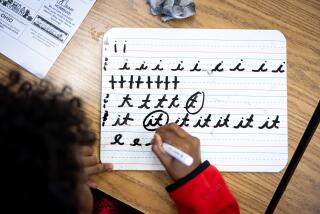Even e-reader owners still like printed books, survey finds
Reading habits may be fundamentally changing, but a new survey shows that the printed word remains fundamental.
Although many Californians who own Kindles, Nooks and other e-readers love their gadgets, they still prefer books the old-fashioned way — on paper — according to a poll by USC Dornsife and the Los Angeles Times.
Even with sales of e-readers surging, only 10% of respondents who have one said they had abandoned traditional books. More than half said most or all of the books they read are in printed form.
The pleasure of reading endures in the digital age, even with its nearly boundless options for entertainment, according to data collected from 1,500 registered state voters. Six in 10 people said they like to read “a lot,” and more than 20% reported reading books for more than 10 hours a week.
Young adults — often assumed to be uninterested — read about as much as many of their elders. An overwhelming portion (84%) of those ages 18 to 29 said they like to read some or a lot; that’s only a percentage point less than for respondents 50 and older. Sixty-five percent of the younger group said they read books for pleasure three or more hours a week; 69% of those 50 to 64 said the same.
And age is clearly no barrier to new habits. Folks over 50 are embracing some new reading technology at about the same rate as younger people. Twenty-two percent of those ages 18 to 49 own e-readers; 20% of people 50 and older have them.
“I don’t read a whole lot of print anymore,” said Edmund Pieret, 71, an avid reader from Belmont, south of San Francisco. “Since I have an iPhone and a Kindle, I can read anytime I want. If I’m at the doctor’s office, I can pull up any book I own and continue where I left off.”
Reading while relaxing in his spa used to leave Pieret with warped pages and damp bindings. The solution: putting his Kindle in a Ziploc bag.
How much education people have helps determine how much — and how — they read, the poll shows. More than 7 in 10 college-educated respondents said they read “a lot,” while only half of those with no college said they did. Those who went to college are also more likely to use an e-reader.
Owners of e-readers are more likely to read books, read more books and spend more hours each week reading. About 4 in 10 said they devoured four or more books a month.
Technology has turned Fred Kaviani away from the printed book.
“When you travel for work a lot — which I used to do — carrying books is bulky,” said Kaviani, a sales manager. “So I got turned on to books on tape — that was the first step. From there I went to the iPod. Now I have a Kindle Fire.”
Today, the 49-year-old Westwood man said, he reads only two or three printed books a year: “Usually when someone gives me one as a gift.”
But the sensation of hefting a physical book, opening its thick cover and turning its delicate pages is hard-wired in some people. Words illuminated on screens are a cold substitute.
Betty Beasley’s parents instilled a love of reading in her when she was a child. Her father was a former teacher, their home was full of books and Beasley spent countless hours at the public library.
Over the years, the 77-year-old Los Angeles resident collected hundreds of novels and nearly a thousand cookbooks. When she moved from a house to an apartment a decade ago, she reluctantly parted with most of them.
When members of her book club bought e-readers, Beasley, who said she reads three books a month, got one too. A year later, it sits in a drawer with one unread download: “The Count of Monte Cristo.”
“I’m old-school. I just love books,” Beasley said. “I’m a bibliophile.... It’s nothing against technology. It’s just a habit. I like to touch a book, turn the pages. It’s tactile.”
The poll was conducted for USC’s Dornsife College of Letters, Arts and Sciences and the Los Angeles Times by two companies: Greenberg Quinlan Rosner Research and American Viewpoint. The survey took place March 14-19. The margin of error is 2.9%.
More to Read
Start your day right
Sign up for Essential California for news, features and recommendations from the L.A. Times and beyond in your inbox six days a week.
You may occasionally receive promotional content from the Los Angeles Times.






